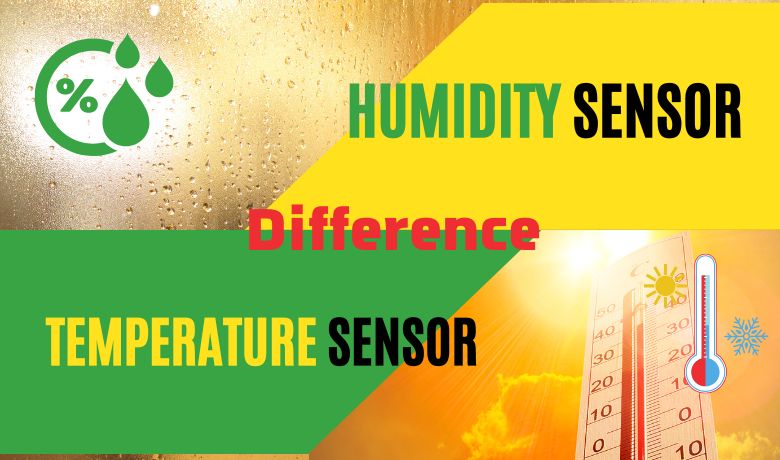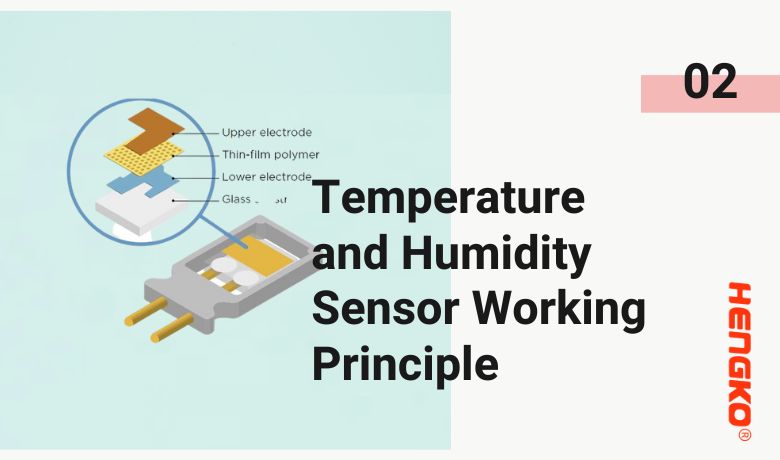How Does Temperature and Humidity Sensor Work?
What Is The Temperature And Humidity Sensor?
Temperature and humidity sensors (or RH temp sensors) can convert temperature and humidity into electrical signals that can easily measure temperature and humidity. Temperature humidity transmitters on the market generally measure the amount of temperature and relative humidity in the air, convert it into electrical signals or other signal forms according to specific rules and output the device to the instrument or software to meet the environmental monitoring needs of users.
What is the Working Principle of Temperature and Humidity Sensors?
The components of the temperature and humidity sensor module mainly include a humidity-sensitive capacitor and a conversion circuit. The humidity-sensitive capacitor comprises a glass substrate, a lower electrode, a humidity-sensitive material, and an upper electrode.
Humidity-sensitive material is a kind of high molecular polymer; its dielectric constantly changes with the relative humidity of the environment. When the environmental humidity changes, the capacitance of the humidity-sensitive element changes accordingly. When the relative humidity increases, the humidity-sensitive capacitance increases, and vice versa. The conversion circuit of the sensor converts the change in humidity-sensitive capacitance into a change in voltage, which corresponds to a relative humidity shift of 0 to 100% RH. The output of the sensor shows a linear shift of 0 to 1v.
How to choose Temperature and Humidity Sensors for Your Project?
Which Sensor is Used for Temperature and Humidity?
First, the frequency response characteristics: the frequency response characteristics of the temp and humidity sensor determine the frequency range be measured. They must maintain the measurement conditions within the allowable frequency range. The sensor response always has an unavoidable delay—the better. The sensor's frequency response is high, and the frequency range of the measurable signal is wide. Due to the influence of structural characteristics, the inertia of the mechanical system is significant. The frequency of the measurable signal of the sensor with a low frequency is low.
Secondly, the linear range: the linear range of the temperature and humidity device refers to the content in which the output is proportional to the input. In theory, within this range, the sensitivity remains constant. The more comprehensive the linear range of the sensor, the more extensive the field, and it can ensure sure measurement accuracy. When selecting a sensor, when the type of sensor is determined, it is first necessary to see whether its range meets the requirements.
Finally, stability: the ability of the temperature and humidity device to remain unchanged after a period of use is called stability. In addition to the structure of the sensor itself, the factors that affect the sensor's long-term stability are mainly the sensor's use environment. Before selecting a sensor, you should investigate its use environment and select the appropriate detector according to the specific use environment.
What is the Difference Between Temperature Sensor and Humidity Sensor?
Temperature Sensor: Temperature is the most common environmental parameter. Temperature plays an essential role in our homes and industries. Over the past few years, we can monitor and control ecological parameters with the help of temperature-sensing devices. A temperature sensor is an electronic device that detects and measures accurate temperature levels in different environmental conditions. Many affordable temperature sensors are available to measure the precise temperature level.
Humidity Sensor: Humidity is another most measurable environmental parameter. The high humidity levels in our homes and warehouses increase the chances of damaging products and things. In the past, we could not detect the proper humidity level due to a lack of sensing devices. The humidity sensor is an electronic device used to measure the humidity level and make changes in the humidity level through our mobile phones from anywhere. The humidity sensor detects the humidity level in the water, air, and soil. We can easily access humidity sensors in our homes and business.

For now, most meters, sensors and transmitters, most of the device have both functions and can monitor or test humidity and temperature. Sure, if you like to only test temperature or only moisture, you can check some of our devices on our products page.
What is the Range of the Humidity Sensor Mean?
The humidity sensor with single active material has a limit in the detecting ranges. The GO, PEDOT: PSS, and Methyl Red materials have sensing responses of 0 to 78% RH, 30 to 75% RH, and 25 to 100% RH, respectively.
How do I know if my humidity sensor is working?
You can Do and Check The Steps as follow:
1. A small food storage bag that zips.
2. A tiny cup or bottle cap from a 20-ounce soda.
3. Some table salt.
4. Water.
5. Put the cap and the hygrometer inside the baggie.
6. Wait 6 hours. During this time, the hygrometer will measure the humidity inside the bag.
7. Read the hygrometer. ...
8. Adjust the hygrometer if necessary.
What About the HENGKO Temperature and Humidity Sensor?
The HENGKO temperature and Humidity sensor adopt a large-size LCD screen and keys. Built-in high-quality temperature humidity sensor module imported from Switzerland, with high measurement accuracy, strong anti-interference ability, etc., to ensure the excellent measurement performance of the product. The temperature and humidity are automatically monitored, the value is displayed on the LCD screen, and the data is uploaded to the monitoring software through RS485 or wifi signals.
Our temperature and humidity sensor collects data every 2s. By default, it uploads data every 20s. It also supports adjusting the data upload frequency (Can be set to 1S~10000S/time ) according to the usage environment and the freedom of the recording period between 1 minute and 24 hours Settings. Its internal integrated alarm module (buzzer or relay), we first set the upper and lower limit values of temperature and humidity through the button; once the value exceeds the limit, it will realize the sound and light alarm in place. At the same time, our temperature and humidity sensor also has a powerful storage function; it can store up to 65000 sets of records can be stored.
So if you also have some industrial environment need to monitor and to update the Production and Work Efficiency, you are welcome to contact us by email ka@hengko.com to know more details and solution for temperature and humidity sensor , transmitter and oem humidity probe etc
Post time: Dec-06-2022





